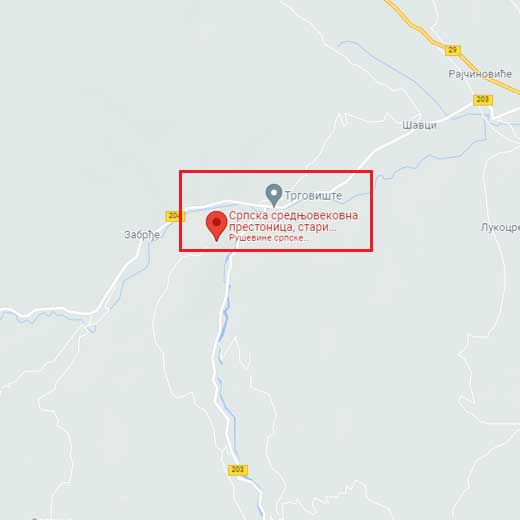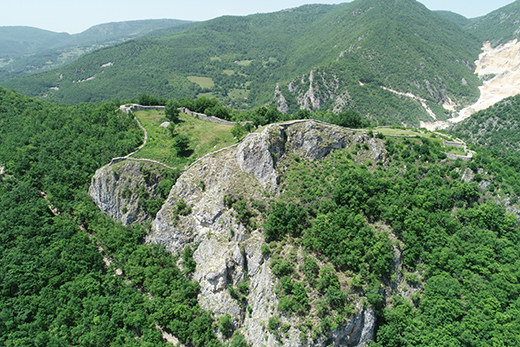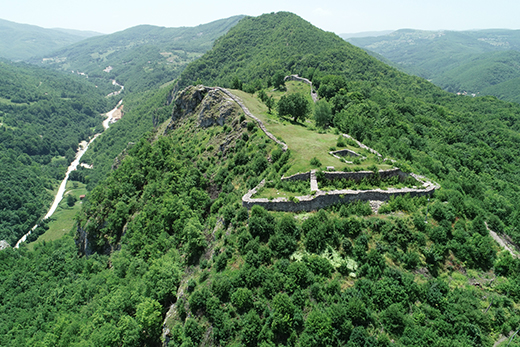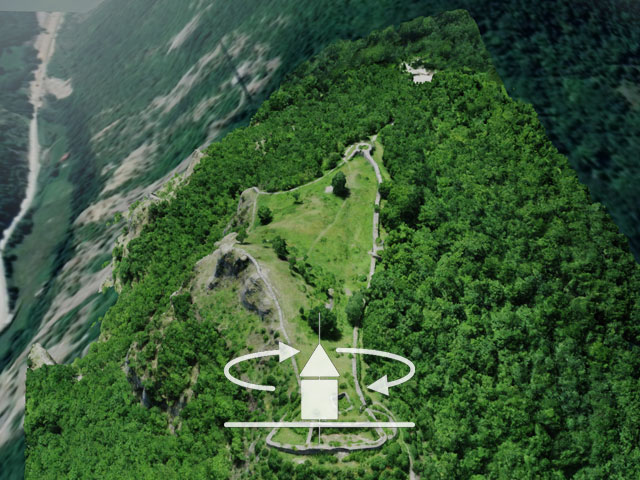Protected cultural monument of exceptional significance, listed as SK 534, PKIC 24 with the Republic Institute for the protection of monuments of cultural heritage.
Monumental complex Old Ras and Sopoćani Monastery have been listed on the UNSESCO list of world cultural heritage since 1979 as the Monumental complex Old Ras and Sopoćani.
Medieval town RasSebečevo and Šavci, Novi Pazar municipality, Raška district
Where is it
Medieval fortification Ras is located on the hill called Gradina above the old Trgovište (Pazarište), above the estuary of the Sebečevska river into the Raška, 11 km west from Novi Pazar.

Research
Archaeological research of the medieval complex Ras begun in 1971. In that same year, the systemic research of the space at the estuary of the Sebečevska river into the Raška, was performed at the localities Gradina, Pećina, Trgovište-settlement and Trgovište- church with necropolis. The research lasted until the end of the 90s of the 20th century. After Old Ras and Sopoćani were enlisted on the UNESCO list of world cultural and natural heritage, the treatment of protection and preservation of this complex has changed.
Ras fortress, built thanks to the efforts of Stefan Nemanja, was a fortified residence of the rulers. This is corroborated by numerous objects found during the research. There are numerous examples of utensils made of clay of local production. However, high percentage of luxurious tableware, imported from all sides of Europe, testifies that the fortification was not inhabited by military personnel only. Among other things, the research discovered the money of king Radoslav (1223-1234) together with the mould for making coins so it is assumed that in Ras, since 1230, the first Serbian mint operated.

History
Ras Fortress was built in the area that used to be inhabited as early as prehistoric times, in the bronze age. The Romans built their military fortification here and in the late antique the civilian settlement was also formed, including buildings for living and a basilica. The name Ras probably derives from the name of the antique fortification Arsa as mentioned by the Byzantine historian Procopius in the 6th century.
Medieval Ras was first mentioned by Byzantine emperor Constantine VII Porphyrogenitus who wrote about the fights between the Serbs and the Bulgarians at the end of 9th century. Between 9th and 12th century, the fortress was conquered by the Bulgarians, then the Serbs and the Byzantines, intermittently.
Fortified medieval town was founded in the early 12th century, during the reign of the Byzantine emperor John II Komnenos, as verified by the findings of Byzantine coins.
In the mid-12th century, Ras became the capital of the Nemanjić dynasty, political, economic and cultural seat of the Serbian state and maintained that significance throughout the 13th century. In the 14th and early 15th century, the political significance of the city-fortress declined, but it remained an important economic centre, especially thanks to the development of trade between Dubrovnik and the Eastern countries. The adjoining settlement, Trgovište, became quite a trading centre with its two-story houses inhabited by wealthy merchants.
The city was conquered in 1455 by the Turks who founded the nearby Novi Pazar. Ras and Trgovište started losing their earlier significance.

Description
The fortification of the elongated shape of irregular quadrangle, length 180 and width 20-60 meters, was erected on the high plateau. One rampart was built along the ridge from which the terrain descends steeply, so the entrance from that side is nearly impossible. Parallel with it, there is another rampart on the other side that has a much milder slope and is therefore fortified with four smaller towers and one big keep. The keep, with a semi-circular base 8 meters in diameter, was in the south, where it was easiest to access the fortress. The ramparts were built with broken and hewn stone, bound by lime, 1,50 to 2,10 meters wide and up to 7 meters high. The main city gate was on the western rampart, defended by two towers. The smaller gate was on the southern side.
When the Serbs conquered Ras, it was necessary to strengthen the fortification and build new, necessary objects inside the fortress. It was then that the western gate was walled up, and a new gate was broken next to the main tower. All rampart towers were also fortified. Two new edifices in the northern part of the town were most probably ruler residencies, the court of the Serbian Grand perfect. The living area was on the ground floor, 300 square meters, and the edifices were mutually connected. One of the cellars contained a grain storage, the biggest known in the Balkan countries of the Byzantine world. The other cellar had a separate entrance ramp. The basement parts of the edifices were built in stone, and the upper parts were mostly made of wood, as well as the roof cover.
Next to them, a tower was built, meant not only for defence, but also for living.
The other edifices were mostly made of wood, with small stone foundations.
Old Trgovište
The research of Trgovište (Pazarište) revealed a big civilian settlement of 64 houses, with masonry basements and upper wood construction. Vast archaeological material testifies to the life in the settlement. Numerous utensils made of clay were discovered, both for food preparation, but also more luxurious tableware. A lot of metal objects were also discovered, jewellery, objects made of bone testifying on the life of the inhabitants of Trgovište. All these materials are kept in the Ras Museum in Novi Pazar.
Julka Kuzmanović Cvetkovićarcheologist
